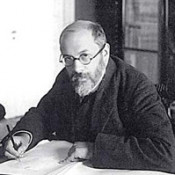
Birthday anniversary of Alexander Benois, a Russian artist and art historian
Alexander Nikolayevich Benois, a Russian artist, an art historian and critic was born on April 21 (May 3), 1870 in Petersburg.
Alexander Nikolayevich comes from the family famous for its artistic talents. Thus K. A. Kavos, Benois’ great grandfather from his mother’s line, was a composer and a conductor; his grandfather was an architect who designed several theaters in Russia; his father also was an eminent architect and the older brother Albert was a known watercolor painter.
In 1885-1890 Benois studied at K. I. Maya gymnasium and attended classes at the Academy of Arts. In 1894 he graduated from Law Department of Petersburg University. He studied the art history on his own, he painted (mostly with watercolor) and drew.
His work as a painter was related to two major subjects: ‘France of Louis XIV age’ and ‘Petersburg of 18th – beginning of 19th century’. The same topics were essential in his theatre works and writing. Benois had made illustrations for A. S. Pushkin ‘The Queen of Spades’, published ‘Alphabet in paintings by Alexander Benois’. The illustrations to Pushkin’s poem ‘Bronze Horseman’ which took the painter 20 years of work finally proved to become a real masterpiece of graphic art.
In 1898 Benois organized ‘Mir Iskusstva’ (The world of Art), a society of like-minded people and a journal. Among the members of the circle were Benois’ friends from gymnasium and University: Dmitry Philosophov, Walter Nouvel, Konstantin Somov; later it was joined by Sergey Dyagilev, Leon Bakst, Alfred Nurok. One of the distinctive features of ‘Mir Iskusstva’ painters was their many-sidedness. They worked as painters, graphic artists, decorative and applied arts.
Benois was not only a practitioner but also a theorist of art. In 1901-1903 he wrote many articles on painting, architecture, music, theater, published in ‘Artistic treasures of Russia’ historical collected articles, in such journals as ‘Mir Iskusstva’, ‘Moscow weekly’, ‘Old years’, ‘The Golden Fleece’. In 1904 his works were published in ‘Slovo’, ‘Rus’ and ‘Rech’ newspapers. In 1911 was issued Benois’ ‘Guide on Hermitage picture gallery’; from 1917 to 1917 his periodical issue ‘Painting history of all times and peoples’ had been published. Alexander Benois’ fundamental works are ‘Russian school of painting’, ‘Tsarskoye Selo during the reign of Elisaveta Petrovna’ and ‘General history of painting’.
Theater activity of Alexander Nikolayevich started in 1902 when he designed scenery for Wagner’s ‘Twilight of the Gods’ opera in Mariinsky Theater. On his initiative was organized a private ballet troupe ‘Russian seasons’ which began to perform in 1909 in Paris. Benois occupied the post of the director for arts and decorated some of the performances. In 1911 Alexander Benois designed stage scenery and wrote a libretto for I. Stravisnky ballet ‘Petrushka’. In 1913-1915 he worked as an artist and stage director at Moscow Art Theater; in 1919-1925 worked at the Bolshoi Drama Theater and Opera and Ballet Theater in Leningrad.
From 1918 to 1926 Benois was the Chief curator and the Head of Hermitage picture gallery. In 1926 the painter emigrated to France where he worked for the most part in a theater. At first it was Grand Opera of Paris and after the World War II – ‘La Scala’ in Milan.
Alexander Nikolayevich Benois died on February 9, 1960 in Paris.
Lit.: Бенуа А. Азбука в картинах. СПб., 1904; То же [Электронный ресурс] URL:http://imwerden.de/pdf/benua_azbuka_1904.pdf; Бенуа А. Н. История живописи. Т. 1-4. СПБ., 1912-1917; То же [Электронный ресурс]. URL: http://www.benua-history.ru/; Бенуа А. Н. Мои воспоминания. М., 1990; Эткинд М. А. Н. Бенуа и русская художественная культура конца XIX — начала XX века. Л., 1989.
Based on the Presidential Library’s materials:
Мутер Р., Бенуа А. Н. Русская живопись в XIX веке // История живописи XIX в. М., 1900 .

